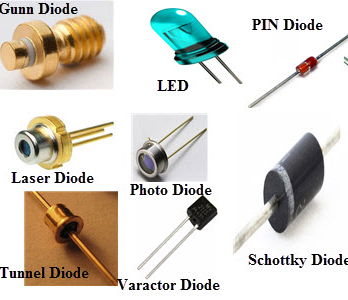The diode is one of the basic non-linear circuit components which conducts the current in only one direction. In operation, it is analogous to a mechanical check valve that allows the flow of fluid in one direction and blocks the flow in another direction. Similarly, diode also allows the flow of electron in only one direction, known as the forward direction. This unidirectional behavior is also known as rectification and is used to convert alternate current(AC) to direct current(DC). It would not be wrong to call this basic element as the flag bearer of the electronic edge.

Earlier diodes were thermionic diodes or vacuum diodes.which were bulky and required a heating element to operate. Before 1919, these were known as rectifiers and the effect was known as Edison effect. First engineering use of diode (other than scientific experiment) was for precision radio detection, nearly 20 years after the discovery at Marconi Company. Most commonly used diode today is the crystalline semiconductor p-n junction. The first semiconductor diodes developed around 1906, were made of mineral crystals such as galena. But today use of silicon, selenium, and germanium are more common. Current day technology also induces impurity in mineral crystals very precisely to control the properties of the current flow. Diodes are extensively used as rectifiers, signal limiters, voltage regulators, switches, signal modulators, signal mixers, signal demodulators, photo-detector, Ionizing radiation detectors, current steering, and oscillators. These are only a few application to be named, but its application is not limited only to these.

A diode can be characterized based on the method it is made or its intended application. The symbol for the different type of diode has only minor differences, but every symbol has a triangle pointing towards the forward direction, i.e. in the direction of conventional current flow.
Real diodes are somewhat different than the ideal diode due to physical limitations of the device. A real diode requires a voltage to be maintained in the forward direction for current to flow. i.e. When the cathode is at a negative potential then the anode and forward break-over voltage is maintained, then current flows through the diode. The forward break-over voltage is approximately 0.6 Volt for silicon devices, 0.3 Volt for germanium devices, and 1 Volt for selenium devices. If the cathode is at a higher potential or anode to cathode potential difference is less than the forward break-over voltage only small leakage current will flow which can be neglected in most of the cases. This general rule doesn’t hold if the cathode voltage is positive relative to the anode voltage by enough amount. This reverse potential causes the junction to break and current flow to establish in reverse direction. Based on the diode type this breakdown voltage can be classified as Zener breakdown or Avalanche breakdown. Also, the breakdown voltage varies based on material and process of manufacturing.


There are several types of diodes, which emphasize either a different physical aspect of a diode by geometric scaling, doping level, choosing the right electrodes.
- Avalanche Diode
- Zener Diode
- Cat’s whisker or crystal diodes
- Constant current diodes
- Esaki or tunnel diodes
- Gunn diodes
- Light-emitting diodes (LEDs)
- Laser diodes
- Thermal diodes
- Perun’s diodes
- Photodiodes
- PIN diodes
- Schottky diodes
- Super barrier diodes
- Gold-doped diodes
- Snap-off or Step recovery diodes
- Stabistors or Forward Reference Diodes
- Transient voltage suppression diode (TVS)
- Varicap or varactor diodes
- Point-contact diodes
Now that your current has a specific direction, it’s time to put your basic knowledge to test. Browse more application specific articles related to this little yet powerful semiconductor device or go in-depth with “The transient response of p-n junction diode”. If you are new in the world of electronic design find our article “Demystifying the diode data-sheet”.
- Introduction to diode
- Avalanche Diode
